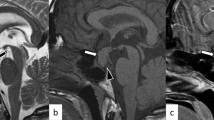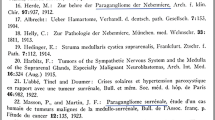Summary
Follicles of ganglion cells in the adrenal medulla of the young Syrian Hamster are investigated with the light and electron microscope.
Ganglion cells and their processes, satellite cells and presumably fibroblasts build up the wall of the follicle. The ultrastructure of these cells resembles in principle that of nerve cells in adult animals.
-
1.
Ganglion cells. Golgi apparatus and Nissl substance show no peculiarities. Intracellular and extracellular inclusions are identical with the formerly described colloid-filled vacuoles. On the surface of the cells a few microvilli-like structures are to be seen. Neurites and dendrites cannot be distinguished. From the interior and outside of the follicle neurites come into contact with ganglion cells forming synapses among which the axo-dendritic type is predominant.
-
2.
Often only satellites and their processes together with neurites of the first neuron and ganglion cell processes form the barrier between the follicle and the extrafollicular space. Such parts of the follicle are called “openings”. Here satellites send many tiny processes into the colloid.
-
3.
The contents of the follicle is the same as that of colloid-filled vacuoles. Besides the existence of the follicle the occurrence of 0,1–1 μm particles near the luminal surface probably supports the hypothesis of a secretory activity of the cells. The satellites, too, may be considered as the source of secretory products. There is no evidence for the assumption that colloid is extruded through the openings or reabsorbed by the cells. Macrophages in the colloid however ingest colloidal material.
Zusammenfassung
Im Nebennierenmark (NNM) junger Goldhamster kommen Follikel aus Ganglienzellen vor. Ganglienzellen und ihre Ausläufer, Satellitenzellen und vielleicht auch Fibroblasten bilden die Follikelwand. Die Ultrastruktur dieser Zellen entspricht weitgehend der vom erwachsenen Tier her bereits bekannten.
-
1.
Ganglienzellen. Golgiapparat und Nissl-Substanz zeigen keine Besonderheiten. Einschlüsse, die auch extrazellulär liegen können, entsprechen den bekannten Kolloidvakuolen. Die lumenwärts gelegenen Zelloberflächen weisen nur wenige mikrovillusartige Strukturen auf. Die Ganglienzellfortsätze können nur schwer nach Axonen und Dendriten getrennt werden. Von der Follikelinnen- und -außenseite treten Axone an Ganglienzellen und ihre Ausläufer heran und bilden Synapsen. Der axo-dendritische Typ überwiegt.
-
2.
Satellitenzellen und ihre Ausläufer können zusammen mit Axonen des I. Neurons und Ganglienzellausläufern die einzige Barriere zwischen Follikel und Interzellularraum darstellen. Solche Abschnitte des Follikels werden „Öffnungen“ genannt. Satellitenzellen entsenden hier winzige Fortsätze ins Kolloid.
-
3.
Der Follikelinhalt unterscheidet sich nicht von dem vakuolenhaltiger Ganglienzellen. Zugunsten eines Sekretionsprozesses spricht außer der Existenz der Follikel vielleicht auch das Vorkommen 0,1–1μm großer Körperchen am Follikelrand. Auch die Satellitenzellen müssen als Sekretbildner in Betracht gezogen werden. Einen Anhalt für Kolloidabgabe durch die Follikelöffnungen oder für Rückresorption gibt es nicht. Im Follikel gelegene Makrophagen nehmen jedoch Kolloid auf.
Similar content being viewed by others
Literatur
Bargmann, W.: Über intrafollikuläre Blutungen in der Schilddrüse der Selachier. Anat. Anz. 88, 41–48 (1939).
—: Über die neurosekretorische Verknüpfung von Hypothalamus und Neurohypophyse. Z. Zellforsch. 34, 610–634 (1949).
—: Neurosecretion. In: Int. Rev. Cytol. 19, 183–201 (1966).
—, u. E. Lindner: Über den Feinbau des Nebennierenmarkes des Igels (Erinaceus europaeus L.) Z. Zellforsch. 64, 868–912 (1964).
Becker, K.: Über die vakuolenhaltigen Nervenzellen im Ganglion cervicale uteri der Ratte. Ein Beitrag zur Frage der peripheren Neurosekretion. Z. Zellforsch. 88, 318–339 (1968).
Graumann, W.: Beobachtungen über Bildung und Sekretion perjodatreaktiver Stoffe im Nebennierenmark des Goldhamsters. Z. Anat. Entwickl.-Gesch. 119, 415–430 (1956).
Jewell, P. A.: The occurrence of vesiculated neurons in the hypothalamus of the dog. J. Physiol. (Lond.) 121, 167–181 (1953).
Lupulescu, A., and A. Petrovici: Ultrastructure of the thyroid gland. Basel (Switzerland) and New York: S. Karger 1968.
Smollich, A.: Die Follikel des Nebennierenmarks der Wiederkäuer. Pathol. Veterinaria 2, 161–174 (1965).
Unsicker, K.: Über die Ganglienzellen im Nebennierenmark des Goldhamsters (Mesocricetus auratus). Ein Beitrag zur Frage der peripheren Neurosekretion. Z. Zellforsch. 76, 187–219 (1967).
Verney, E. B.: The antidiuretic hormone and the factors which determine its release. Proc. rox. Soc. B 135, 25–106 (1947).
Zambrano, D., and E. De Robertis: Ultrastructure of the hypothalamic neurosecretory system of the dog. Z. Zellforsch. 81, 264–282 (1967).
Author information
Authors and Affiliations
Rights and permissions
About this article
Cite this article
Unsicker, K. Follikel aus Ganglienzellen im Nebennierenmark des Goldhamsters (Mesocricetus auratus). Z. Zellforsch. 95, 86–101 (1969). https://doi.org/10.1007/BF00319270
Received:
Issue Date:
DOI: https://doi.org/10.1007/BF00319270




